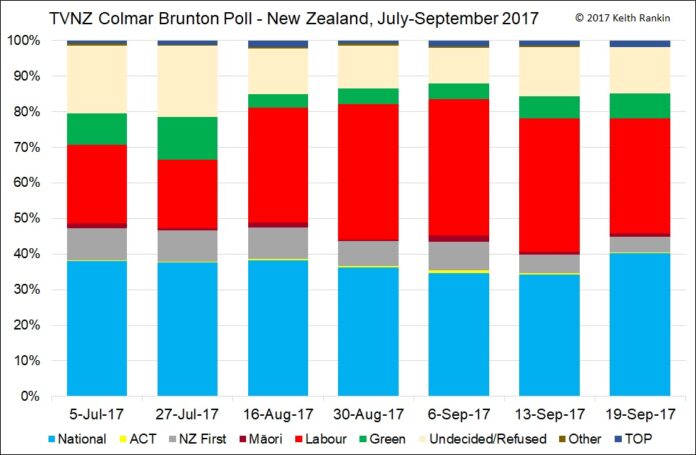Analysis by Keith Rankin – Correcting the Polls
In the Scoop report of the most recent (16-19 Sep) Colmar Brunton political poll, we see the numbers adding up to 112.3%. This innumerate reporting – a result of Colmar Brunton’s own reporting method – represents one of the biggest flaws of political polling. It de-emphasises the most important statistic, the ‘undecided’ vote. We sometimes forget that the whole point of election campaigns is for parties to convince undecided voters to vote for them. The final election result comes as undecided voters make up their minds. Good polling will show whether undecideds are indeed making up their minds.
Today’s chart reports the TVNZ Colmar-Brunton polls from July, with undecided (and refused-to-say) voters included. The chart sequences the parties with the National bloc (including New Zealand First) at the bottom, with the Labour bloc above. The most likely pivot point is the Māori Party, placed here between New Zealand First and Labour. Parties unlikely to make the cut are shown at the top.
If all the undecided voters do in fact vote, the critical percentage should be between 48% and 49%. In the most recent poll, the National bloc is showing at 45%, meaning that if 30% of the undecideds support National, Act or New Zealand First, then those parties will be in position to form a government. This should happen if enough of the undecideds are undecided between parties in that bloc. But if the main source of indecision relates to Green versus Labour, then most of the undecided votes will be votes for a new Prime Minister.
The chart shows clearly that most of the support gained by Labour after its leadership change came from the Greens and the undecideds. After that, some support seeped from the National bloc to the Labour bloc. The 13 September poll appears to have been a ‘rogue poll’ (overstating Labour). By definition, 1 poll in 20 will be outside the margin of error.
In mid-September, we saw an increase in the undecided proportion. It’s less clear whether this represents people contemplating a switch in intent from the Labour to National.
My sense is that the final result will be an average of the 6 September and 19 September polls, with undecideds slightly in favour of a change of Prime Minister.
]]>








